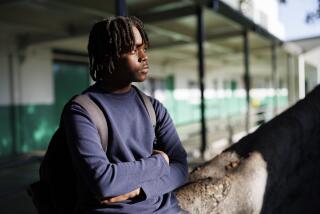Breaking the Cycle of Poverty
- Share via
Nearly a decade ago, Los Angeles’ longest-serving mayor launched what he often said he hoped would become one of his strongest legacies.
Tom Bradley, who overcame an impoverished childhood to make history as the city’s first African American mayor, envisioned an after-school enrichment program that would begin in 10 of the city’s most destitute neighborhoods and, within 20 years, spread to all the elementary campuses in the gigantic Los Angeles Unified School District, making it by far the largest and most ambitious such project in the nation.
He wanted the city and the district, with generous private support, to create safe, fun environments that would steer youngsters away from the lure of street gangs and drugs and improve their prospects for success in the classroom and in life.
As it looks to its 10th year, LA’s BEST (Better Educated Students for Tomorrow) has fulfilled many of its founder’s hopes, winning acclaim and many emulators across the country.
Yet a large chunk of the dream has been deferred: Today, the program operates at just 24 of the district’s 418 elementary campuses, its expansion slowed to a crawl by a perennial shortage of money. Also, the program faces an unprecedented budget crisis as funding from the beleaguered Los Angeles Community Redevelopment Agency, which has covered the bulk of LA’s BEST’s operating budget, is due to dry up with the end of the fiscal year June 30.
Mayor Richard Riordan, who has warmly embraced the program he helped shape as a Bradley appointee to its founding committee, has promised to find replacement funds. In addition, LA’s BEST directors have made moves--including a painful board reorganization and the recent hiring of a seasoned fund-raiser--aimed at increasing the already substantial business and philanthropic support for the program.
“As a struggling organization, we have taken the steps we needed to; we’ve done what we can,” said Carla Sanger, who has headed the program since its inception. “The ball is now in the city’s court.”
The budget problems deepened as program officials prepared to launch a yearlong series of anniversary celebrations for what has been, by many measures, a big success.
Open after school until 6 p.m. daily, the program provides--at no cost to parents--supervision, tutoring, enrichment classes, sports, art and other activities, with monthly field trips and sessions to help youngsters build self-esteem and resolve conflicts.
It gives 5,000 children ages 5 through 12 a safe and productive alternative to being home alone or out on the streets in some of the city’s most troubled neighborhoods.
The program has earned supporters across a broad spectrum of political, education, business and community factions. About one-fourth of its $3.3-million operating budget comes from private donors. The school district provides space and administrative support and recently added LA’s BEST to its list of organizations that can benefit from voluntary employee payroll deductions for charities.
It enjoys enormous popularity with its young participants and their parents: Almost half its campuses have waiting lists, and a number of earlier graduates have returned as volunteers or staffers. Many of the program’s employees live within two miles of their campuses, a fact Sanger credits for helping build a stronger connection between the schools and their poverty-ridden, increasingly immigrant communities.
Margarita Dominguez, now 18 and a freshman math major at Cal State Dominguez Hills, attended LA’s BEST at Hawaiian Avenue School in Wilmington. She juggles classes to work two days a week at a program she remembers as helpful--and a lot of fun.
“We had cooking classes and a lot of field trips. One day [a city recreation staff member] brought Nintendo; it was the first time I ever played a video game,” recalled Dominguez, who lives in the sprawling public housing project that borders the elementary campus near Los Angeles Harbor.
Now she tutors kindergartners and first-graders, teaches the recorder and works with the program’s drill team.
“We had a lot of help with our homework. I had a lot of help in math, and that is now my strong subject. I was really a shy little girl,” Dominguez said, adding that the program “made me a lot more outgoing.”
She said that her young charges come for the fun and that they seem to know they have something special.
“They always say they can’t miss because they are afraid they will get taken off the roster,” she said. “They know there is a waiting list, and if they can’t come for even a day they always let us know.”
LA’s BEST kids get lots of opportunities to show their stuff--music and drill team competitions, opening celebrations of community facilities, annual sports playoffs. Shortly after Bernard C. Parks was named police chief, an LA’s BEST program was a prominent stop on his whirlwind city tour with Riordan.
Corporate donors have provided scores of goodies, from annual family passes to opening day at a water park and circus tickets to computers and science programs that are shared with the rest of the school during regular class hours. Last spring, the 10 winners of the LA’s BEST Science Fair and their parents won free trips to the U.S. Parent/Child Space Camp in Huntsville, Ala.
On Monday, LA’s BEST students at Grape Street School in Watts will meet one of Hollywood’s most influential figures. Jeffrey Katzenberg of the DreamWorks SKG studio will visit them to announce a new animation program. Students at Grape Street and three other LA’s BEST campuses will learn to make short animated features that will be used as public service announcements.
Those kinds of activities are what lure children to the program. Once there, they benefit in ways that attract grown-up supporters.
A 1995 UCLA analysis of the program found that participants showed “significantly greater motivation and enthusiasm for school” than classmates who were not in LA’s BEST. Students who had been in the program at least two years also showed gains in all five subjects analyzed: math, science, social studies, reading and composition.
LA’s BEST children stood out from their peers in other important ways too, the study found: They regarded teachers and other grown-ups as more helpful, reported knowing more people who had attended college, showed more interest in trying new activities and expected to complete more grades in school.
Not surprisingly, the program has attracted attention from policymakers and others looking for ways to break the cycle of poverty and failure. Programs patterned on LA’s BEST have sprung up in Sacramento, San Jose and San Diego, and local directors have received inquiries from more than 200 other cities seeking advice on creating similar after-school projects. Last year the Carnegie Task Force on Learning in the Primary Grades cited LA’s BEST as one of five after-school programs in the country that best foster children’s learning and social development.
Currently on Gov. Pete Wilson’s desk is legislation (AB 326) that would provide $3.5 million statewide for after-school programs modeled on LA’s BEST. If the governor signs the bill, the city will apply for some of the funds, Sanger said. Additionally, Sen. Barbara Boxer (D-Calif.), citing LA’s BEST as her model, has introduced federal legislation calling for $50 million to start as many as 500 after-school programs nationwide.
The irony of having to battle for the life of a program that has so extended its reach is not lost on Sanger.
“It’s not often that we come up with a formula that works,” she said of all the efforts over the years to solve some of society’s most pressing problems. “Now we have it. We have found a way to lift children beyond their environments, to make a difference in their lives, and we can’t find a way to support it.”
Most philanthropists prefer to pay for experimental programs but are reluctant to fund ongoing, nuts-and-bolts needs such as salaries, administration, monitoring and independent evaluation, she said.
Until now, the CRA has picked up the tab for most of those costs. But the agency’s recent loss in a protracted court battle to lift a spending cap, along with changes in state redevelopment law, have dried up the money for LA’s BEST and several other social service programs that the agency has been underwriting.
Riordan, who has long leveraged his personal wealth and civic clout to try to improve the schools, pronounced LA’s BEST “the best program of its kind” in the nation, saying it is a cost-efficient way of “giving these kids a much better start in life.”
He has directed three department heads to find room in their budgets for the program and said he will ask the City Council to help fund it when he writes his budget proposal this spring.
“It will be a challenge,” Riordan said, acknowledging that budget writers must first discover ways to close a projected deficit of at least $57 million in the overall spending package.
“But I like challenges. This is something I’d like to see on every campus. All our kids can benefit from it. So we need to expand, let alone make up the shortfall” from the loss of the CRA money, Riordan said.
More to Read
Sign up for Essential California
The most important California stories and recommendations in your inbox every morning.
You may occasionally receive promotional content from the Los Angeles Times.











